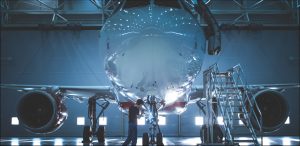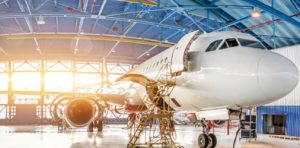The commercial aviation industry had seen many ups and downs over the years. But the digital age has pushed it to move forward with the rise of the emerging markets across many continents.
The change on aircraft fleet design, model and number concurrently requires attention on maintenance, repair and overhaul (MRO) demand.
According to global management consulting firm Oliver Wyman’s 2016-17 Airline Economic Analysis highlights, Asia will lead the highest growth in engine, especially India and China, nearly doubling in service fleet and related MRO demand.
But as technology is embracing the betterment in detecting damaged parts or optimizing repair processes, aircraft maintenance is still overwhelmingly dependent on human touch.
By this, experts mean that new hardware and software advances have opened doors to automation.
This is not to say robots will be replacing mechanics, but they will likely be heavily aiding them in turn reducing MRO costs for airline operators and lessors.
With the expansion of business in the commercial aviation industry, the maintenance, repair, and overhaul (MRO) market that supports it is also expected to grow.
Total MRO spend is expected to rise to $116 billion by 2029, up from $81.9 billion in 2019. Aside from the growth in the fleet, the increase will be driven by more expensive maintenance visits and technology enhancements, according to Oliver Wyman.
Growing fleet sizes, technology advancements, stronger economies and aging fleets are driving MRO spend and modernization. Global management consulting firm Oliver Wyman says the global MRO spend is expected to rise to $116 billion by 2029, up from $81.9 billion in 2019.
The annual average growth rate for the MRO market will be 3.5 percent over the decade. More of this growth will take place between 2024 and 2029, when MRO spend will grow $19 billion versus $15 billion between 2019 and the start of 2024.
The escalating number of newer- generation aircraft that enter the fleet will drive the slower initial five years. These aircraft have longer maintenance intervals and replacement thresholds for such things as life-limited parts than older jets.
A high-ranking Boeing staff and Lim Serh Gee, President ST Engineering’s aerospace sector, tell us how industry 4.0 is making waves in the MRO industry in an email interview.
New technologies
New MRO technologies are already taking an upper hand as they are being implemented across commercial, business and government aircraft. On the commercial side the market is experiencing a technological revolution today, providing a holistic approach to air travel, enabling data collection, automation and artificial intelligence.
“Within the MRO industry, technological advances are improving data availability, which is driving efficiencies, safety, reliability, visibility and lowering overall operating costs. GaN (Gallium Nitride), radar processing technology, blockchain, as well as growth in data analytics and applications. These technological trends are driving increased aircraft and equipment modifications and upgrades in order to capture the benefits of new capabilities that are often significantly improved over the previous years,” a Boeing staff who asked not to be named explained.
Lim Serh Gee, said, “Leveraging Industry 4.0 driven technologies and going digital brings along with it a host of benefits for the MRO industry. Firstly, it helps to improve workflow and efficiency at the operational level by creating better visibility of the workflow so that any deviation or error during the work process can be spotted and rectified expeditiously.
“Secondly, the digital data collated can be harnessed for data analytics, enabling more in-depth analysis of the work done for further performance enhancement.”
 Pushing boundaries
Pushing boundaries
Boeing estimates that 70% of platform life cycle costs are attributed to services. Global economic conditions coupled with the current geopolitical environment are increasing the emphasis on availability in certain markets, resulting in increase in MRO parts and labor spend.
Growing fleet sizes, stronger economies and aging fleets are driving MRO spend and modernization.
“In the instance of our MRO business, given that we support many different customers whose aircraft types overlap, we can use the vast data collected from the aircraft we service, analyze them and provide predictive maintenance solutions. With predictive maintenance, we can be better prepared in terms of manpower planning and spare provisioning when an aircraft is inducted for MRO work.
“We have a dedicated data analytics team working on this, who actively engage the customers to see how we can meaningfully harness data analytics to create value for them,” notes ST Engineering’s Lim Serh Gee.
 The Boeing staff said, “Regionally the fastest growth in the commercial market will occur in Asia Pacific and the MENA region. The Middle East market will expand nearly twice as fast as North America, driving by interior modifications as the airlines compete for business and try to capture ancillary revenues. In contrast, maturing fleets will witness slower growth in the largest market North America that accounts of more than half of the global fleet. The labor supply challenge is magnified in Asia Pacific because of its strong growth forecast”.
The Boeing staff said, “Regionally the fastest growth in the commercial market will occur in Asia Pacific and the MENA region. The Middle East market will expand nearly twice as fast as North America, driving by interior modifications as the airlines compete for business and try to capture ancillary revenues. In contrast, maturing fleets will witness slower growth in the largest market North America that accounts of more than half of the global fleet. The labor supply challenge is magnified in Asia Pacific because of its strong growth forecast”.
 Asia Pacific’s MRO spend has been high and is expected to continue rising due to the growth in the regional fleet. This fleet growth is in tandem with the economic growth of the region, a fast growing middle class especially in China and liberalization of air traffic, according to ST engineering.
Asia Pacific’s MRO spend has been high and is expected to continue rising due to the growth in the regional fleet. This fleet growth is in tandem with the economic growth of the region, a fast growing middle class especially in China and liberalization of air traffic, according to ST engineering.
Aging aircraft maintenance
Boeing estimates that over the next 10 years, around 25% of the worldwide fleet will be retired and replaced, driving increased demand for services to maintain aging aircraft, extend service life and enhance aircraft capability.
“Commercial aircraft and fleet owners perform in house or outsource some or all of their MRO services to 3PLs. Although some airlines are choosing to bring work in house, there is a steady trend for select operators, particularly in startups of low cost carriers, or business and general aviation, to forego the expense of setting up full time service maintenance departments, opting instead to selectively outsource these services.”
The ST Engineering President added: “In addition to digitization and data analytics, ST Engineering has been investing in smart technologies in two other focus areas – robotics and additive manufacturing.
“The former not only helps to lower costs and increase productivity, but also help improve safety and consistency in work quality. An example of us using automation in MRO work is a solution that we developed ourselves to carry out visual inspection of the exterior of an aircraft by leveraging smart drone technologies. Named DroScan, the tool eliminates the work safety concern of a human inspector climbing up and down work stands to carry out the actual work. The tool also applies algorithms and data analysis capability to help diagnose any defects captured by the drone camera effectively.”
Additive manufacturing
Parts and supply chain are known to be the largest aftermarket segment, correlating with MRO activity. Growing fleet, utilization and aging aircraft are driving this growth.
However, the use of additive manufacturing (3D printing) in the aerospace sector has gone up over the recent years. Printing of complex aircraft components instead of assembling them from various parts will gradually become a common industry standard.
As the acceptance of technology improves in the MRO industry, so does addictive manufacturing vice versa. It will evolve from being used on non–critical flight components to being a common approach to deliver and manufacture high quality parts, with lower turnaround times and reduced costs.
Lim Serh Gee, explains, “On the additive manufacturing (AM) front, we have been working closely with interested airline customers and conducting trials to create a virtual warehouse for cabin parts, especially those that require frequent replacement or long procurement lead time.
“As an MRO company with engineering capabilities, we do not just merely do replacement with 3D-printed part. We also work on certifications with the aviation authorities so that the parts that operator’s want 3D-printed can be approved for use in their aircraft. The study into 3D-printing these parts is also usually accompanied by design optimization.
“We have been working closely with various customers, including Air New Zealand, to produce AM parts per their request. Our latest project is a Proof of Concept involving the use of block chain and AM technologies to achieve a digital supply chain, which was done in collaboration with Air New Zealand, MOOG and Microsoft.
“Through these efforts, we hope to move closer toward Supply Chain 4.0 whereby a virtual warehouse can be developed with 3D-printed just-in-time cabin parts designed and certified by us. This will greatly help to decrease lead times and result in less down time for our airline operating partners.”
The percentage of new, next- generation commercial aircraft increase to over 50 percent of the fleet by 2028, from 13 percent today, says Boeing. This will lead technological shifts for MRO providers as they acclimate to handle new materials such as the composite structure and the increasing flow of data generated by 787.
Newer fleets also impact the scope of maintenance and maintenance intervals, especially for heavy checks and engine maintenance.
MRO providers are provided to invest in training, digital capabilities and infrastructure upgrades to support next generation aircraft. With cost being a significant factor, this can also be a challenging factor for some MRO’s and may result in consolidation in the industry.
MRO needs are driven by age of aircraft and fleet diversity; however, MRO providers tend to be more specialized and will be invest in tools and infrastructure unless they are under contract.
Current technological trends
While definitely inspiring, some new technological solutions are being realization and an exception in the MRO industry. For the most parts, robotics are being discussed as valuable for inspection automation tasks and restricted to less critical aircraft systems.
 As new applications are definitely underway, it might take time for them to be applied in the MRO industry. ST engineering’s Lim Serh Gee concludes our interview by tell us some of the upcoming major trends to have the biggest impact in the MRO industry.
As new applications are definitely underway, it might take time for them to be applied in the MRO industry. ST engineering’s Lim Serh Gee concludes our interview by tell us some of the upcoming major trends to have the biggest impact in the MRO industry.
“Some of major trends that we believe will have great impact on the MRO industry include: Increasing introduction of new- generation aircraft which could alter maintenance cycle; MRO growth driven by significant increasing narrowbody aircraft deliveries; market consolidation; and an increasing number of OEM licensed service centers to support fleet renewal and fleet growth.
“All these trends will potentially lead to the stiffening of competition. What will set one apart from the rest is how well one can provide the services, and not just in setting up hangars.
“Airlines will want to partner trusted service providers with a strong record who can provide integrated maintenance support as they renew or grow their fleet. Productivity and safety focus becomes vital, which explains the immense amount of time and resources in smart technologies that ST Engineering invests in to increase productivity and safety levels in every aspect of our operations.”











